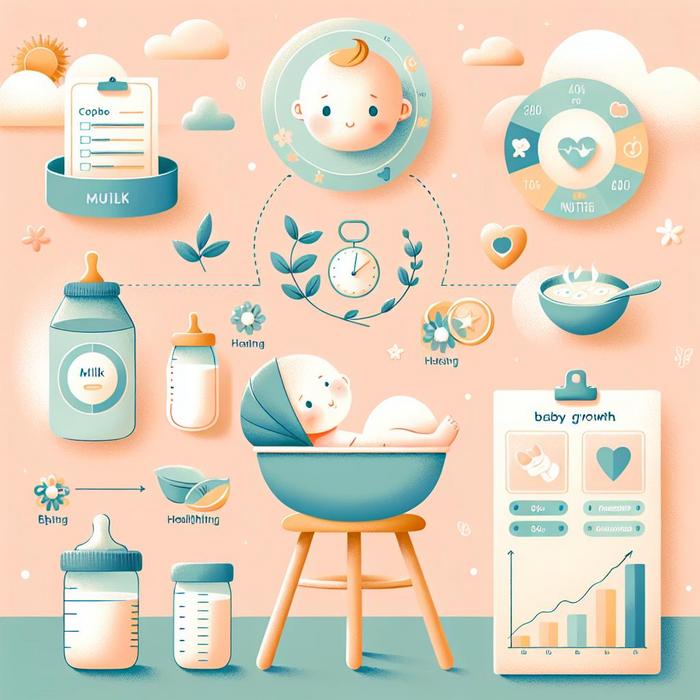Understanding Your Baby’s Feeding Needs
Ensuring your baby is getting enough milk intake can be anxiety-inducing for many new parents. If you find yourself questioning if your little one is on track, don’t panic, this is a very common concern, especially for first-time parents. Stay confident in your parenting by staying informed and learning the signs that indicate your baby is indeed having enough milk.
The Importance of Milk Intake for Your Baby’s Health
Milk plays a pivotal role in your baby’s growth and development. According toParents.com, babies mainly rely on milk for their first year of life, as it is the primary source of nutrition. The right quantity and quality of milk intake are key to boost their overall health and wellness.
Here are some benefits that sufficient milk intake contributes to your baby’s health:
- Provides necessary nutrients for growth
- Strengthens the immune system
- Improves cognitive development
- Ensures proper hydration
Decoding Your Baby’s Signals
Babies are not always vocal about their needs, but they give out signals that can help us identify whether they are having proper milk intake. Here are some signs to watch for:
- Sufficient weight gain: One of the most direct signs that your baby is getting enough milk is consistent weight gain. Consult your pediatrician for the right growth chart for your baby.
- Regular bowel movements: A baby who is getting enough milk will have regular, healthy bowel movements. An infant’s stool is usually pale yellow and semi-solid.
- Active and Alert: If your baby is active during feeding sessions and alert during wakeful periods, they might be getting enough milk.
You can learn more about these signs from leading health organizations. The Johns Hopkins Medicine guide on feeding in the first year is a great resource.
Conducting the Feed Test
The feed test is a simple way to monitor your baby’s feeding habits and determine if they are getting enough milk. Keep a diary and note down every feeding session, the duration, and the baby’s behavior during and after feeding. Detailed records help you spot any discrepancies and provide valuable information to your healthcare provider if you have any concerns.
Adjusting Your Baby’s Milk Intake
If you suspect that your baby is not getting enough milk, it’s crucial to reach out to your pediatrician promptly. Remember, every baby is unique, and a feeding schedule that works for one may not necessarily work for another. Keep yourself updated with the latest feeding trends and research on baby feeding to ensure your baby is receiving the proper nutrition.
Understanding your baby’s milk intake is an iterative process. It’s normal to experience some bumps along the way. Stay patient, ask for support, and most importantly, trust yourself. You are doing a great job!
The Science Behind Baby’s Milk Requirement
The question of how much milk a baby needs can be complex, as it varies widely depending on the baby’s age, weight, and overall health. In general, babies require about 2.5 ounces of formula per pound of body weight each day. You would limit this amount to about 32 ounces in 24 hours once your baby starts eating solid foods at around six months old, as per KidsHealth.
Other factors may also influence milk intake, including growth spurts that might increase appetite and the introduction of solid foods which might decrease reliance on milk for nutrition.
Formula Feeding: Quality and Frequency
Formulas are designed to mimic breast milk, providing all the necessary nutrients that an infant needs for the first year of life. Depending on the baby’s age and weight, the amount and frequency of formula feedings would differ. For further clarity, refer to this feeding guide by the HealthyChildren.org.
Breastfeeding: Quality and Frequency
Babies who are exclusively breastfed may feed more frequently, as breast milk is more easily digested than formula. A newborn might need to breastfeed every one to three hours, while an older baby might go for longer periods between feedings.
Keep in mind that the quality of the milk (in terms of nutrient value) also matters, not just the quantity. Nutrient-rich breast milk or a well-balanced formula can nourish your baby effectively even in lesser volumes.
Baby Feeding and Nutrition beyond Milk: Introduction to Solids
When your baby is about six months old, your pediatrician might advise introducing solid foods gradually while continuing to provide milk for nutrition. You can gradually increase the variety and quantity of solids as your baby grows and becomes more accepting of new tastes and textures. Check out this comprehensive guide on baby’s first solid foods from the UK’s NHS.
Choose the Right Feeding Method for Your Baby
Feeding your baby is not just about the milk/formula and solid foods; it’s about the method of feeding as well. Some babies feed better from a bottle, while some prefer breastfeeding. Experiment with different feeding methods and see what works best for your baby.
Trust Your Instincts
As a parent, intuition is your powerful ally. Your baby might not always be able to tell you what they need, but you often instinctively know what’s right for them. Trust your intuition and your knowledge of your baby— you know them best. Listen to their signals, monitor their growth and changes, and respond with love and care. Your baby’s healthy development and happiness are your best rewards.
Remember, you are doing a fantastic job, and love is the best ingredient in any feeding relationship.






